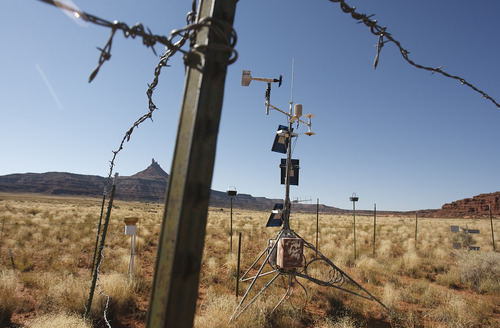This is an archived article that was published on sltrib.com in 2011, and information in the article may be outdated. It is provided only for personal research purposes and may not be reprinted.
A warmer Southwest might very well mean a dustier Southwest.
That's the conclusion of a new study by researchers at the U.S. Geological Survey and the University of California-Los Angeles that has far-reaching implications for all of Utah, where healthy range is vital to livestock, wildlife and recreation, as well as air quality and water supplies.
Seth Munson, a USGS ecologist and the study's lead author, noted that looking at how climate change might affect wind erosion in arid landscapes is an important new area of research.
With climate change, temperatures are expected to increase. That, in turn, means more evaporation, less soil moisture and fewer grasses and some shrubs, which help protect the soil from blowing away in the stiff winds that rip through Utah from the south and west.
"You're going to have less vegetation," said Munson, "and more dust."
Ultimately, it could also mean poor air quality in northern Utah's cities and a faster-melting snowpack in the mountains, which normally serve as a kind of freezer storage for the basin and desert water supply.
"Dust coming from the drier regions in Utah," Munson added, "causes exceedances of air-quality standards in Salt Lake and the rest of the Wasatch Front."
Since the 2007 Milford Flat Fire, the largest fire in Utah history, the loss of soil crust and vegetation has led to some significant dust storms in northern Utah, the scientist noted. "We've learned a lot from that."
Munson worked with USGS colleague Jayne Belnap and Gregory S. Okin, of the geography department of UCLA. The three published their research recently in the peer-reviewed Proceedings of the National Academy of Sciences.
The research team used data collected over 20 years at Arches and Canyonlands national parks. It found that, when temperatures increased, perennial vegetation in grasslands and some shrublands declined. It also used the moisture and vegetation measurements in a computer model to project what is likely to happen in the future.
Munson said some of the good news in the study is that, while we might not be able to stop climate change, we can take steps to prevent one of its side effects — soil erosion — with sensible management.
The study found, for instance, that biological soil crusts held up well against climate shifts. Data collected in the national parks, where the land is largely protected from vehicles, livestock and other disturbances, suggest that vulnerable areas outside the parks can also be managed to minimize soil impacts.
Lisa Bryant, a soil scientist for the U.S. Bureau of Land Management in Utah, said information like the climate-dust study helps her agency formulate its plans for the 22.9 million acres under its jurisdiction in Utah.
"Science like this is trying to answer some of the questions we're looking at," she said, noting that the BLM is factoring climate change into its own decisions and adapting its management accordingly.
The BLM can use the data, for instance, to determine whether to change the grazing season on sensitive livestock allotments, the best location for a new power plant or how to deal with wildfire.
Whether or not climate change is behind future droughts, smart adaptive management can help protect resources important to well-being, Bryant said. "Soil is a basic resource for how we live and how we use the land."
What are biological soil crusts, and why shouldn't you trample them?
Biological soil crusts are those dark mossy-looking mats often found in low-traffic areas of the desert that are not covered by other types of vegetation. Made up of cyanobacteria, mosses and lichens, the crusts grow even under severe conditions. But they don't stand up well to traffic, from vehicles, livestock or people. And when they are gone, the underlying soil is vulnerable to erosion in the 50 or more years that it takes for the protective blanket to grow back.
Source: soilcrust.org





